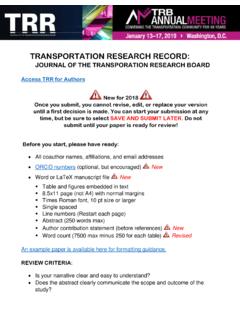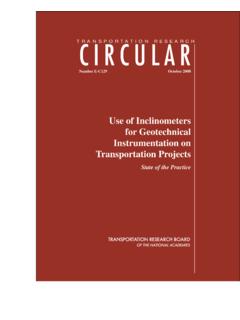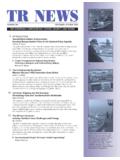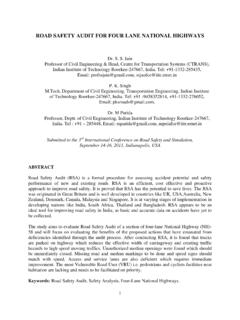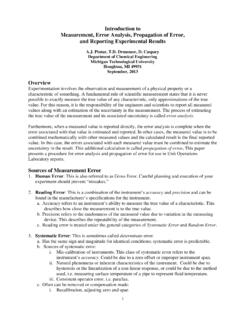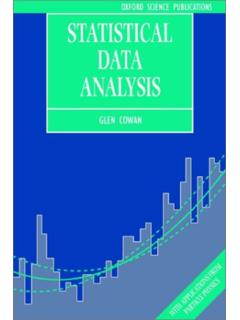Transcription of Data Management, Analysis Tools, and Analysis Mechanics
1 Volume II: page 99 Chapter 2 data management , Analysis Tools, and Analysis Mechanics This chapter explores different tools and techniques for handling data for research purposes. This chapter assumes that a research problem statement has been formulated, research hypotheses have been stated, data collection planning has been conducted, and data have been collected from various sources (see Volume I for information and details on these phases of research). This chapter discusses how to combine and manage data streams, and how to use data management tools to produce analytical results that are error free and reproducible, once useful data have been obtained to accomplish the overall research goals and objectives. Purpose of data management Proper data handling and management is crucial to the success and reproducibility of a statistical Analysis . Selection of the appropriate tools and efficient use of these tools can save the researcher numerous hours, and allow other researchers to leverage the products of their work.
2 In addition, as the size of databases in transportation continue to grow, it is becoming increasingly important to invest resources into the management of these data . There are a number of ancillary steps that need to be performed both before and after statistical Analysis of data . For example, a database composed of different data streams needs to be matched and integrated into a single database for Analysis . In addition, in some cases data must be transformed into the preferred electronic format for a variety of statistical packages. Sometimes, data obtained from the field must be cleaned and debugged for input and measurement errors, and reformatted. The following sections discuss considerations for developing an overall data collection, handling, and management plan, and tools necessary for successful implementation of that plan. The data Collection, Handling, and management Plan The data collection, handling, and management plan plays an important role within a research project.
3 The plan provides a roadmap documenting the flow of data through the sequential phases of collection, storage, cleaning, reduction, Analysis , and finally to archiving. Further, the management plan documents the relationships between all of the software tools and programs necessary to guide the data through this research life cycle. Volume II: 100 The data handling and management plan needs to be developed before a research project begins. The plan, however, can evolve as the researcher learns more about the data , and as new avenues of data exploration are revealed. Considerations The data collection, handling, and management plan addresses three major areas of concern: data Input, Storage, Retrieval, Preparation; Analysis Techniques and Tools; and Analysis Mechanics . These concerns are not independent, and have synergistic impacts on the plan. Provided below is a list of questions that must be considered when formulating a data collection, handling, and management plan.
4 Although the questions are organized into three major categories, many questions raised will affect decisions made in two or more categories. data Input, Storage, Retrieval, and Preparation Are the data clean? The data input process oftentimes introduces typos, miscodes, and errors into the data . (These errors are distinctly different from random or measurement errors introduced in the measurement process). Different storage strategies support differing levels of data editing. [Do the data need to be edited? Do edits need to be tracked?] Are the data static, or will updates be available through the lifetime of the Analysis ? Many data streams are updated periodically. For example, transportation safety data can be updated on an annual basis. Pavement data may be updated on a route-by-route basis as field observations are recorded. [Will new data constantly be added? Will new data be in the same format? Will new fields be added?]
5 ] Are the data obtained from a variety of sources or from a single source? As data are drawn from a greater number of sources, the need for transforming the data to a common format becomes more critical and challenging. Further, one must always consider whether the different sources use the same definitions for common variables. For example, does one source define average delay in the same manner as another? If not, can a simple transformation between definitions be established? How much data will be managed and stored? Different storage strategies support varying record sizes and large numbers of records. [Will storage space be a problem? Will access time be a problem?] Will all data be used in the Analysis , or will subsets of the data be analyzed? To speed Analysis , the researcher will sometimes want to work with a subset of fields rather than all database fields within a record at once. In other cases, only a subset of records will be analyzed.
6 For example, a research may investigate traffic flow and speed relationships for workdays only. [Are sophisticated query and data sub-setting features needed?] Do records in the database share common, duplicated information? Duplicative information wastes storage space, and in some cases creates database problems. In a safety Analysis , for instance, geometric information may be duplicated if accidents occur at Volume II: 101 the same location. Techniques to reduce duplication of information (and thus reduce the overall size of the database) are available. [Are tables needed?] Analysis Techniques and Tools Is the Analysis well defined, or is it more exploratory in nature? For example, are you simply testing statistical differences, or are you looking for unknown relationships? Exploratory Analysis and data familiarity requires graphical tools to help visualize relationships between variables, and requires the researcher to guide the exploration.
7 [Are graphical capabilities needed?] Is the technique well defined, or is it experimental? Well-defined Analysis can be performed by most statistical packages. Specialized software packages and even custom applications developed using programming languages may be required to perform less well known statistical tests or comparisons. [Does the software perform the necessary test or compute the necessary statistics, or will it need to be developed?] Analysis Mechanics Is this a one-time Analysis or will this Analysis be repeated? How often will the Analysis be repeated? The more times an Analysis is repeated, the more important it becomes to automate the Analysis process. This becomes even more important if the Analysis requires that manual transformations be applied to the data . All statistical experiments should be reproducible, not only by other researchers, but by the original researcher also. [Automation: Is a macro or script (small program code that performs a repetitive process) need to be created?]
8 Is a custom program needed?] Will the Analysis be repeated on different data ? Will the data be provided from the new site or device in the same format as the original experiment? [Is a script needed? Is a monolithic application, or a series of filter/transformations needed?] Will multiple researchers access the data , or will only one researcher be performing the Analysis ? As more people become involved in the Analysis , documentation of the Analysis procedure becomes more important. A tradeoff between level of training and level of automation is revealed as more people become involved in the Analysis process. [Will data security be an issue? Will record locking be required? Are varying levels of secure access necessary?] How long does the Analysis take? A computational procedure may require several hours or days to complete. What happens if the procedure is interrupted? Can it be restarted from where it was interrupted, or must the Analysis be restarted from the beginning?
9 data storage: databases and data warehouses The following sections discuss the range of data storage alternatives. Like programming languages, these database solutions differ not so much by what they make possible, but in what they make efficient. Of course, as databases grow in size, efficiency becomes increasingly important. Volume II: 102 The researcher may use one or more of the following solutions in the overall management and handling of data . The key is to recognize that there is not a one-size-fits-all solution, and so the best solution for the particular task at hand must be carefully selected. Small-scale database solutions Text files and spreadsheets are categorized as small databases. In text files, often called flat files, all records related to a particular Analysis are stored in consecutive lines in the file. Text files are the least common denominator of files and are generally used when transferring data from one statistical application to another.
10 From the research perspective, small-scale databases offer several advantages. First, they are simple to understand. All records in the database are the same, and all the necessary information is contained in each record ( , the researcher need not look up additional information in a separate table.) Second, they are simple to use. In general, the researcher will use all the information in the database, rather then selecting a portion of the data . Third, flat-file or spreadsheet databases are simple to update, edit, change, or append. On the other hand, small-scale databases offer several disadvantages. First, they are not designed for querying or locating specific records ( , all the accidents from a specific site.) This becomes a greater problem as the number of records in the database increases, and queries become important. Second, duplicate information across records can increase storage requirements, and result in a propagation of errors through the Analysis .
